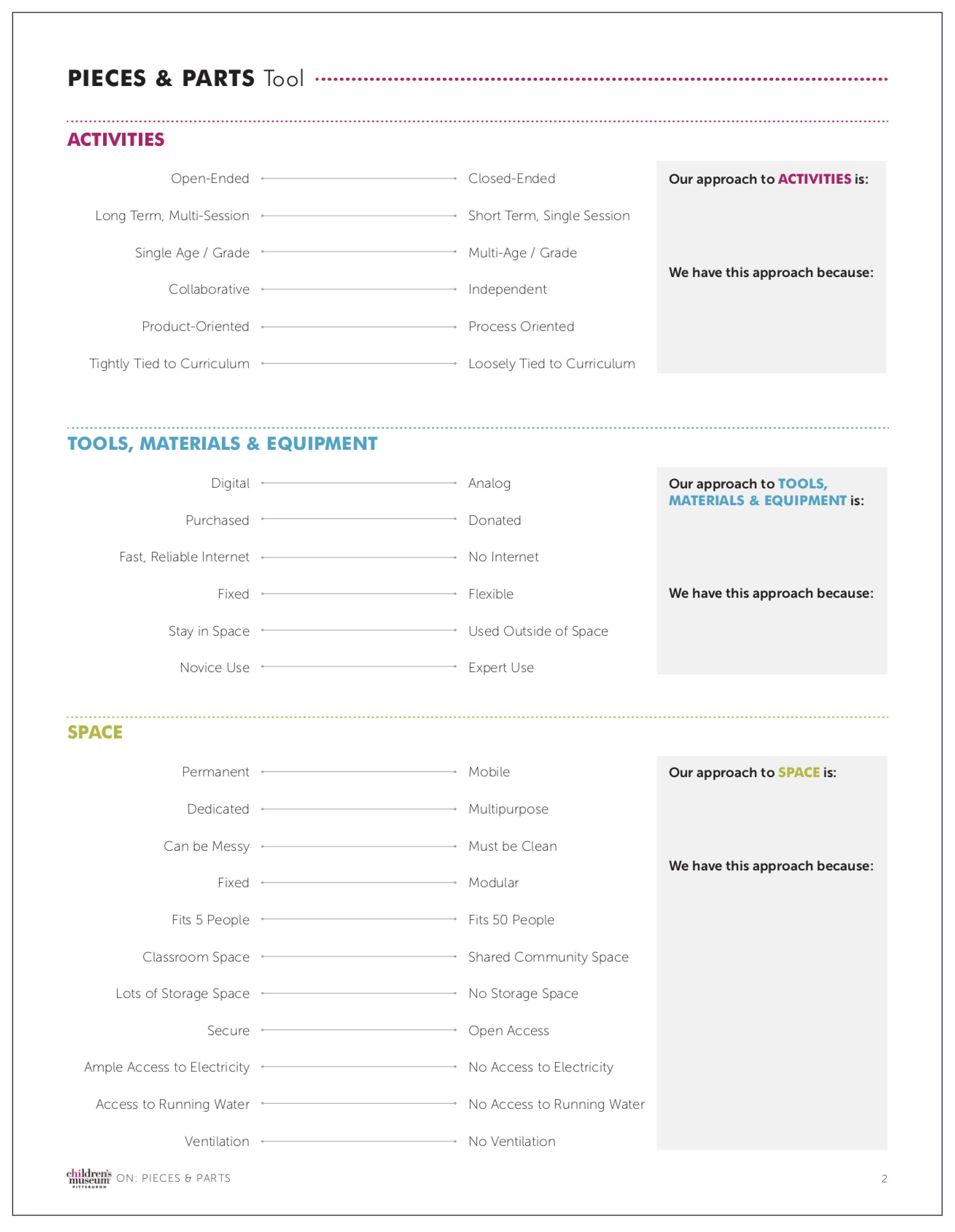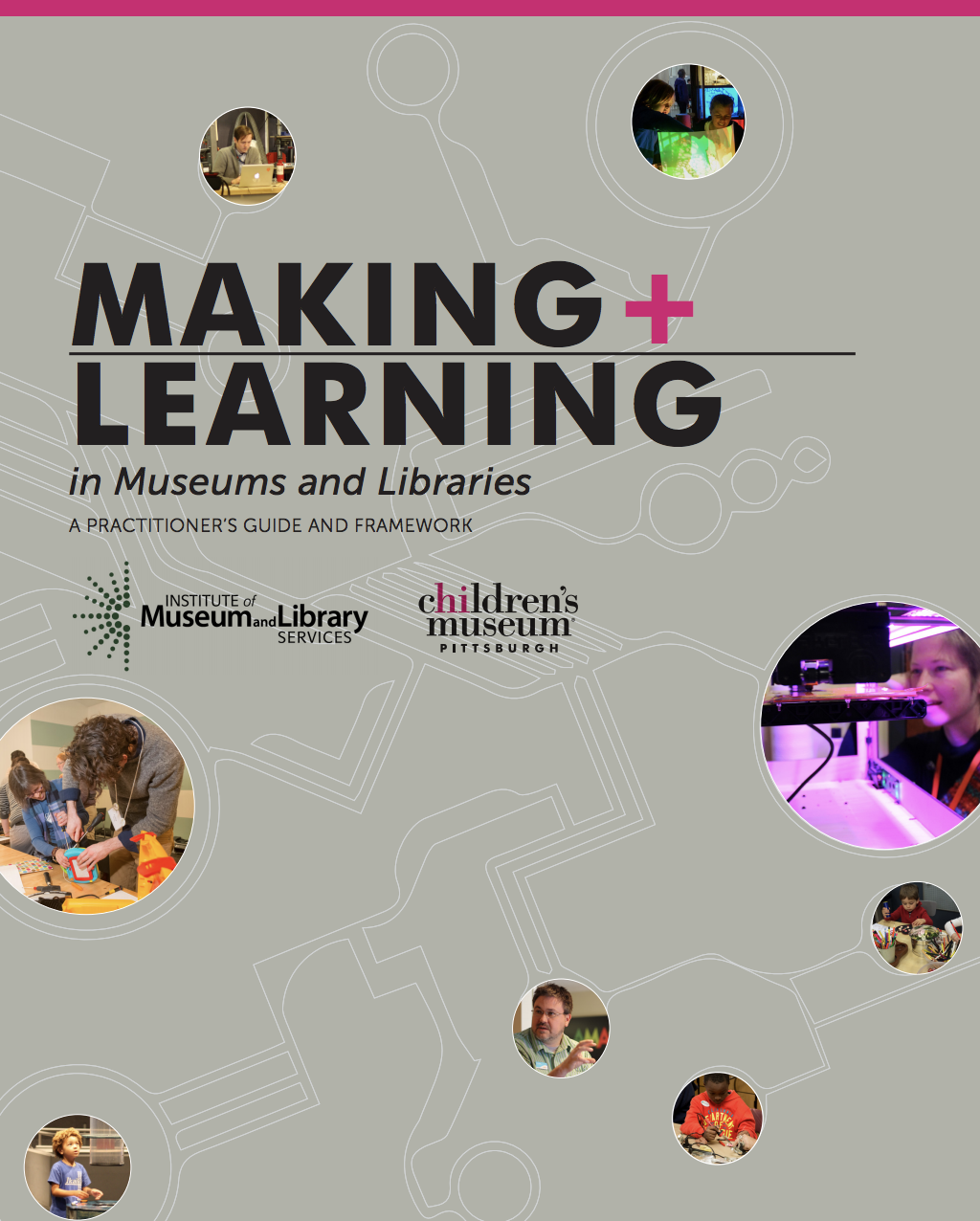There are many different components of any maker learning experience, including activities, physical space, and tools & equipment. This module helps to clarify the pieces and parts by providing a starting point to think about your approach to all components. It may also alternately serve as a point of reflection for what your maker program or space currently encompasses or how it functions.
 Reflect
Reflect
Choose one part of your work as it relates to making, such as the design of the space or a specific program that you want to consider.
 Apply
Apply
 Using the Making Spaces Pieces & Parts tool, mark where your chosen space or program falls on each of the spectra. This tool asks you to consider many of the factors that are often core to designing and maintaining a makerspace. Each end of the spectra doesn’t carry any weight or value, but overall, the spectra are a visible way to show many of the tensions that are often at play when designing making experiences for learners.
Using the Making Spaces Pieces & Parts tool, mark where your chosen space or program falls on each of the spectra. This tool asks you to consider many of the factors that are often core to designing and maintaining a makerspace. Each end of the spectra doesn’t carry any weight or value, but overall, the spectra are a visible way to show many of the tensions that are often at play when designing making experiences for learners.
 Reflect
Reflect
This tool is designed to encourage cross-organizational discussion and consideration of many of the core aspects of a makerspace or maker program activity and practice, as well as how those aspects fit together and impact one another. Choose one or more of the prompts below to extend your reflection and discussion.
- If you’re doing this exercise with colleagues (and each has individually marked his or her spectra), compare your marks and discuss the areas with the largest difference in opinion.
- Is there a difference in your actual lived reality versus your aspirational goals? Your marks may indicate the current status of your program or space. Consider adding an aspirational set of marks for where you want to go next.
- Which of the dimensions might be tightly connected or constrained? For example, you might have a permanent space but it can only fit five people because it’s a converted storage closet.
- What are some additional spectra that you need to consider that are missing from the tool? For example, under activities, you might add: Instructor-Led — Self-Guided. Another important dimension to consider are the people! We’ll explore this next.
 Apply
Apply
Consider additional spectra specific to people that you should think through. For example, what is your staff capacity or staff knowledge (Limited — Extensive)? You could even break this down further by listing particular equipment and defining the time/knowledge needed to operate, teach, and maintain the equipment you have or plan to use.
 Explore
Explore
People are such a critical part of the effort. Use the Planning: Stakeholders & Audience module to dive into deeper exploration of the people involved. Who facilitates? Who manages? Who attends?

Example: Take a look at the following case studies from Making+Learning in Museums and Libraries, written by the Children’s Museum of Pittsburgh and the Institute of Museum and Library Services. This publication includes case studies of the approaches that nine different institutions take in their maker-centered learning experiences. As you read through these three examples, consider the approach you think these institutions take with the Pieces and Parts spectra along the lines of activities, materials, space, and people.
- Betty Brinn Children’s Museum: Connecting Making to the Heritage of a City (pp. 14–15)
- Westport Public Library: Thinking Differently About Staffing Structure (pp. 24–25)
- New York Hall of Science: Viewing Tools in Service of Program Goals (pp. 34–35)
 Explore
Explore
For additional resources that help you think about all the pieces & parts of your program or space, take a look at:
- CSforALL has developed a tool to help schools and districts implement and imbed computer science into their planning and process. This tool, SCRIPT (School CSforALL Resource & Implementation Planning Tool), includes a lot to think about in terms of material selection, leadership, teacher capacity and development, partners, and community.
- To explore how your current staffing supports your work, check out the “People Tool” game by Making+Learning.
This module touched the surface of a lot of different topics. Check out these other modules to dive deeper:
- The Spaces & Places: Locating Learning in Your Environment module considers how the physical space contributes to the learning that happens there.
- Our Space, Tools, and Materials: Reflecting on Design Approaches module takes a look at how you might manage your space and inventory.
- What does your budget look like? Walk through some framing in the Planning: Budget module.
- Connected to the people within a space, think through your Planning: Stakeholders and Audience in our module.
This module was developed in collaboration with Goli Mohammadi (editorial) and Kim Dow (design). Maker Ed would also like to thank Schmidt Futures for supporting the creation of these learning modules.
